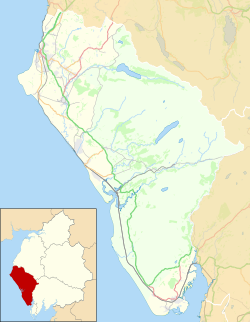| Whitbeck | |
|---|---|
 Whitbeck church, with Black Combe behind | |
Location within Cumbria | |
| Civil parish | |
| Unitary authority | |
| Ceremonial county | |
| Region | |
| Country | England |
| Sovereign state | United Kingdom |
Whitbeck is a hamlet and former civil parish, now in the parish of Whicham, in the Cumberland district, in the county of Cumbria, England. [1] It was called Whidbek in the 1500s. [2]
The Church of St Mary is grade II listed. It is described as "probably medieval in origin, heavily restored 1883". [3]
It is on the A595 road on the south west coast of Cumbria, south west of Black Combe.
In 1931 the civil parish had a population of 150. [4] On the 1 April 1934 the civil parish was merged into Whicham. [5]
William Pearson (1767–1847), one of the founders of the Royal Astronomical Society was born here on 23 April 1767. [6] His parents were William and Hannah (née Ponsonby) Pearson, who owned a farm at Moor Green. [6] [7]
William Pearson wrote the entry for Whitbeck in William Hutchinson's The history of the county of Cumberland..., 1794. [6]

